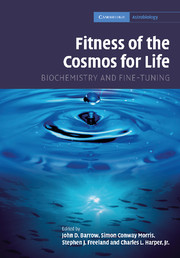Book contents
- Frontmatter
- Contents
- List of contributors
- Foreword: The improbability of life
- Preface
- Acknowledgments
- Part I The fitness of “fitness”: Henderson in context
- Part II The fitness of the cosmic environment
- Part III The fitness of the terrestrial environment
- 10 How biofriendly is the universe?
- 11 Tuning into the frequencies of life: a roar of static or a precise signal?
- 12 Life on earth: the role of proteins
- 13 Protein-based life as an emergent property of matter: the nature and biological fitness of the protein folds
- 14 Could an intelligent alien predict earth's biochemistry?
- 15 Would Venus evolve on Mars? Bioenergetic constraints, allometric trends, and the evolution of life-history invariants
- Part IV The fitness of the chemical environment
- Index
- References
12 - Life on earth: the role of proteins
Published online by Cambridge University Press: 18 December 2009
- Frontmatter
- Contents
- List of contributors
- Foreword: The improbability of life
- Preface
- Acknowledgments
- Part I The fitness of “fitness”: Henderson in context
- Part II The fitness of the cosmic environment
- Part III The fitness of the terrestrial environment
- 10 How biofriendly is the universe?
- 11 Tuning into the frequencies of life: a roar of static or a precise signal?
- 12 Life on earth: the role of proteins
- 13 Protein-based life as an emergent property of matter: the nature and biological fitness of the protein folds
- 14 Could an intelligent alien predict earth's biochemistry?
- 15 Would Venus evolve on Mars? Bioenergetic constraints, allometric trends, and the evolution of life-history invariants
- Part IV The fitness of the chemical environment
- Index
- References
Summary
Introduction
It is now believed that our universe was created around 13.8 billion years ago. Our planet earth came into existence around 4.5 billion years ago. For nearly a billion years or so after it was formed, the earth was stark and bereft of life. The matter contained on earth was inorganic with relatively small molecules. There were endless rock formations, oceans, and an atmosphere.
And then there was life.
The problem of how life was created is a fascinating one. Our focus is on looking at life on earth and asking how it works. The lessons we learn provide hints to the answer to the deep and fundamental question pondered by our ancients: Was life on earth inevitable? Then there are the questions posed by Henderson [1]: Is the nature of our physical world biocentric? Is there a need for fine-tuning in biochemistry to provide for the fitness of life in the cosmos – or, even less ambitiously, for life here on earth? Surprisingly, as we will show, a physics approach turns out to be valuable for thinking about these questions.
All living organisms have a genetic map consisting of a one-dimensional string of information encoded in the DNA molecule. An essential question that one seeks to answer is how an organism converts that information into a three-dimensional living being.
Life has many common patterns. All living cells follow certain simple “universal” themes.
- Type
- Chapter
- Information
- Fitness of the Cosmos for LifeBiochemistry and Fine-Tuning, pp. 225 - 255Publisher: Cambridge University PressPrint publication year: 2007



